‘Solutions to climate change require long-term decisions, long-term investment, long-term planning. We need to see accountability by politicians, 10, 20, 30, 40, 50 years into the future, long after the politician's dead and gone. We get a lot of science ... but it's fair to say that it's often very disembodied. It is knowledge that doesn't have a physical sort of storage; there's no memory of it in our bodies... One of the things that art can do – and it's not the only thing – is it can sort of bring a physical narrative to something that one knows. I think we have a better ability to translate our critical enquiry into action once we have a physical relationship with the world. Bringing an experiential narrative to knowledge ... gives you a certain empowerment. We have a situation now where the whole planet has become conscious about climate change. I think we see a trend how to translate our climate knowledge into climate actions. I hope it's the beginning we are seeing, and not the peak.’ – Olafur Eliasson in the CNN article ‘Olafur Eliasson on what art can do to fight climate change’, 2019
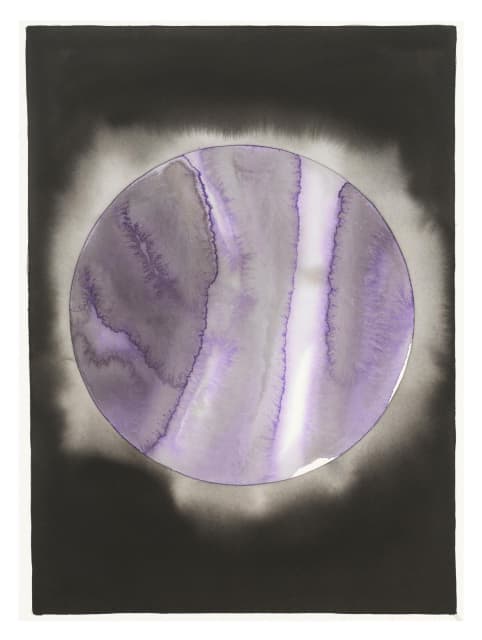
‘A tree on the moon at night’, 2020. Photo: Jens Ziehe
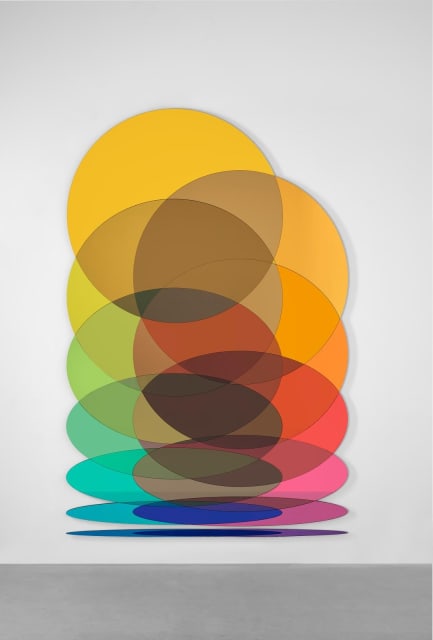
‘Rainbow ellipse progression’, 2020. Photo: Matthias Kolb
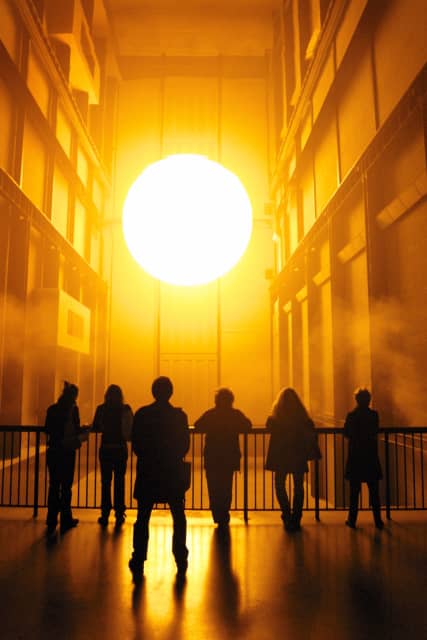
‘The weather project’, 2003, Turbine Hall, Tate Modern, London (The Unilever Series). Photo: Ari Magg
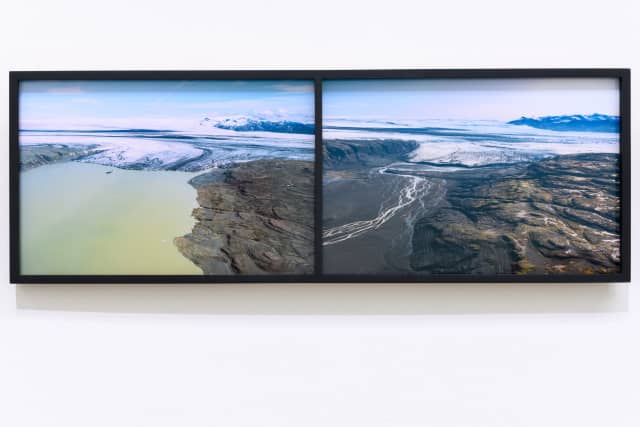
‘The glacier melt series 1999/2019' (detail), 2019, installed at Guggenheim Museum Bilbao, 2020. Photo: Erika Ede. Visit this link to find out more about the artwork and its research context.
We at the studio read this week’s IPCC report, which outlines updated research on carbon emissions and the global climate change trajectory, with sadness and dismay. It notes ‘many changes due to past and future greenhouse gas emissions are irreversible for centuries to millennia. … This includes changes to global sea levels, oceans and ice sheets’. Sea levels are ‘committed to rise’ due to continuing ocean heating and the melting of ice sheets and ‘will remain elevated for thousands of years’.
When Olafur Eliasson undertook ‘The glacier melt series’ in 2019 – a continuation of ‘The glacier series’ from 1999 – we reflected a lot on the IPCC’s research then, and its ramifications for the Earth’s future and our place in it.
‘I expected the glaciers to have changed (with in the last twenty years), but I simply could not imagine the extent of change. All have shrunk considerably and some are even difficult to find again. Clearly this should not be the case, since glacial ice does not melt and reform each year, like sea ice. Once a glacier melts, it is gone. Forever. It was only in seeing the difference between then and now – a mere twenty years later – that I came to fully understand what is happening. The photos make the consequences of human actions on the environment vividly real. They make the consequences felt. … Every glacier lost reflects our inaction. Every glacier saved will be a testament to the action taken in the face of the climate emergency.’ – Olafur Eliasson
Visit this link to see ‘The glacier melt series 1999/2019’ in detail and watch Eliasson in conversation with Katherine Richardson, professor of biological oceanography at the University of Copenhagen and leader of the Sustainability Science Centre, about systemic change and social tipping points.

‘Human time is movement (spring)’, 2019, viewed through ‘Human time is movement (summer)’, 2019. Eliasson's ‘Human time is movement’ works are on view at the Serralves Museum of Contemporary Art, Porto, Portugal, through October. Photo: Filipe Braga.

‘Tomorrow flare’, 2021. Photo: Jens Ziehe
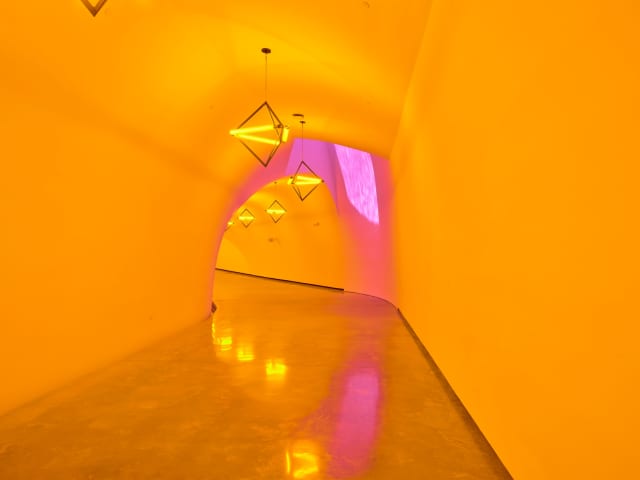
‘Sometimes an underground movement is an illuminated bridge’, 2020, Museum of Fine Arts, Houston, USA
‘Sometimes an underground movement is an illuminated bridge’, 2020, is a site-specific artwork installed in the tunnel linking the Nancy and Rich Kinder Building and the Glassell School of Art at the Museum of Fine Arts, Houston. The work comprises twenty angular light sculptures suspended along the length of the tunnel. Each sculpture contains three monofrequency lamps within a black, bipyramidal steel framework. The lamps infuse the space with a narrow-wavelength of yellow light that reduces the viewers’ spectral range to shades of yellow and grey. By limiting the perceivable color spectrum to a single monochrome hue, the artwork heightens visitors’ awareness, endowing them with a sense of hyper-detailed vision.
Skylights at two points along the tunnel allow natural sunlight to enter the space through panes of purple glass that filter the light and contrast sharply with the yellow lighting. The effect of this intervention changes constantly, as the brightness and quality of the sunlight fluctuate according to weather, season, and time of day. Upon leaving the space, viewers perceive the world in bluish shades – an automatic reaction of the eye to the intense optical stimulation of the yellow environment.
The artwork is an investigation into our perception of colour as a construct, inviting visitors to recognise what happens when the full spectrum of colour is removed.
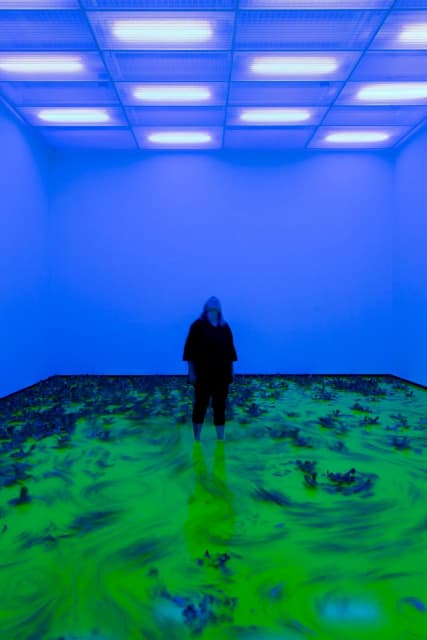
A night view of ‘Life’ at Fondation Beyeler, Basel. Photo: Pati Grabowicz
‘Start with the plants, follow their inquisitive growth, their running roots and rhizhomes, the widespread movements of their pollen and seeds, and an entire ecology of beings and becomings and comings undone will soon become perceptible. Get caught up in the involutionary momentum that propels these beings to get entangled in one another’s lives and you will soon start to perceive affective ecologies taking shape among the thicket of relations all around you.’ – Natasha Myers, anthropologist, from her essay ‘How to Grow Livable Worlds: Ten Not-so-easy Steps’
This text and more can be found on the dedicated website for Olafur Eliasson’s exhibition ‘Life’ at Fondation Beyeler in Basel: https://life.fondationbeyeler.ch/en/

For the many people who are unable to travel to Fondation Beyeler in Basel to see Olafur Eliasson's solo exhibition ‘Life’ in person, the studio has created a special microsite for the project, designed by Henne / Ordnung and full of lush imagery juxtaposed with a diversity of texts and perspectives. We encourage online wanderers to explore the site: https://life.fondationbeyeler.ch/en/
‘Life’ is live! If you are unable to travel to the Fondation Beyeler in person, a specially-produced multi-channel livestream introduces alternating multispecies perspectives of ‘Life’. You can visit this link at any time of day or night to see the exhibition from alternating human and nonhuman perspectives.

Installation view of Future Assembly, now on view in the Central Pavilion at the Giardini in Venice. Future Assembly is Studio Other Spaces' collaborative contribution to La Biennale di Venezia 17th International Architecture Exhibition 'How will we live together?', curated by Hashim Sarkis.
For La Biennale di Venezia 17th International Architecture Exhibition, Studio Other Spaces responds to curator Hashim Sarkis’s question 'How will we live together?' with Future Assembly, a collaboration with six co-designers and fifty Biennale Architettura 2021 participants. The diverse group of designers and spatial practitioners imagine a more-than-human assembly for the future, inspired by the current paradigm for a multilateral assembly – the United Nations.
Located on the mezzanine of the Central Pavilion at the Giardini, Future Assembly comprises a display of fifty more-than-human ‘stakeholders’ from around the world submitted by the participants of Biennale Architettura 2021. These stakeholders – which include, among other things, fungi, estuaries, and ephemeral gases – represent those living and non-living entities whose rights are traditionally left out of human legislation. All fifty stakeholders convene on the shared ground of the Future Assembly World Map, a circular carpet, twelve metres in diameter, woven from up-cycled ocean plastic. Human attempts to recognise and secure the rights of nature during the 75-year history of the Charter of the United Nations are presented in the More-than-human Chart, which spans three walls of the exhibition. Visitors can further explore Future Assembly online at www.futureassembly.earth.
The eight co-designers are Studio Other Spaces (SOS) – represented by its founders, artist Olafur Eliasson and architect Sebastian Behmann – with Caroline A. Jones, professor of art history; Hadeel Ibrahim, activist; Kumi Naidoo, Global ambassador, Africans Rising for Justice, Peace and Dignity; Mariana Mazzucato, professor and founding director of the Institute for Innovation and Public Purpose at University College London; Mary Robinson, chair of the Elders and adjunct professor of climate justice at Trinity College; and Paola Antonelli, senior curator of architecture and design at the Museum of Modern Art, New York.

‘Life’ at Fondation Beyeler, Basel. Photo: Pati Grabowicz
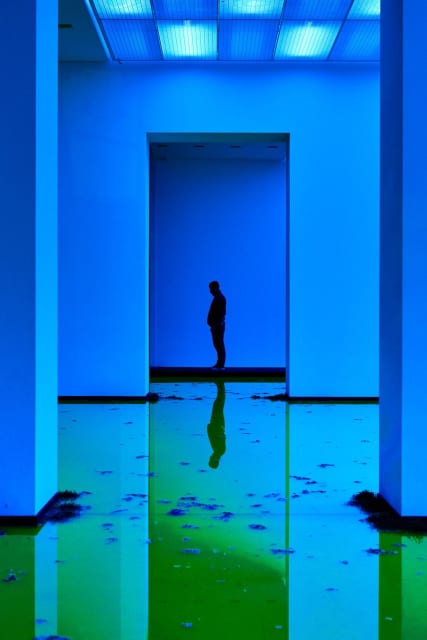
‘Life’ at Fondation Beyeler, Basel. Photo: Mark Niedermann
‘Life’ doesn’t go to sleep at night.
‘Neurobiologist Anna Wirz-Justice has done incredible research into the science of biological time, of our daily rhythms – the so-called circadian rhythms – and into how these rhythms govern human behaviour and physiology. But they also impact most other living organisms – from the smallest bacteria, fungi, and plants to flies and fish and mammals – as they have all internalised these external, geophysical rhythms and have a remarkably similar set of “clock genes” that generate an internal cycle of about twenty-four hours.’ – Olafur Eliasson
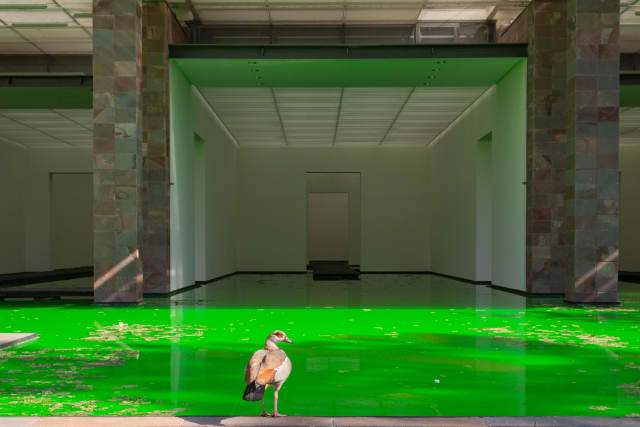
‘Life’ at Fondation Beyeler, Basel. Photo: Patricia Grabowicz
‘“Life” presents a model for a future landscape. It is hospitable. When Sam Keller, the Director of the Fondation Beyeler, and I first discussed the exhibition a couple of years ago, I thought, “Why don’t we invite everyone to the show? Let’s invite the planet – plants and various species.” Beyond just opening a door, I decided to remove the structural boundaries that keep the outside out of the institution, and I am grateful to the Fondation Beyeler and to the architect Renzo Piano, who built the museum, for trusting me to carefully – and caringly – have the glass facade removed from the building. Together with the museum, I am giving up control over the artwork, so to speak, handing it over to human and non-human visitors, to plants, microorganisms, the weather, the climate – many of these elements that museums usually work very hard to keep out. Instead, we are trying to welcome everyone and everything in.’ – Olafur Eliasson

‘Life’ at Fondation Beyeler, Basel. In collaboration with VOGT Case Studio. Photo: Patricia Grabowicz
‘Ever since I began practising as an artist in the early 1990s, I have been interested in perception and in the cognitive and cultural conditions that shape it. “Life” comes to life through your active encounter with it, through your perception. I’ve chosen not to offer a didactic or explanatory text to accompany the artwork, as this might shape visitors’ perceptions and understandings of the exhibition. It’s important to me not to share a finite perspective on “Life”. At the same time, I welcome what visitors bring with them to the artwork, their expectations and memories, thoughts and emotions.’ – Olafur Eliasson

Olafur Eliasson’s exhibition ‘Life’ is in continuous transformation, and anyone visiting the park surrounding the Fondation Beyeler in Basel can see the artwork as it develops. The exhibition has slowly started to emerge and will fade away in July. In this way, the construction and deconstruction of ‘Life’ become integral parts of the artwork. In collaboration with VOGT Case Studio. Photo: Patricia Grabowicz
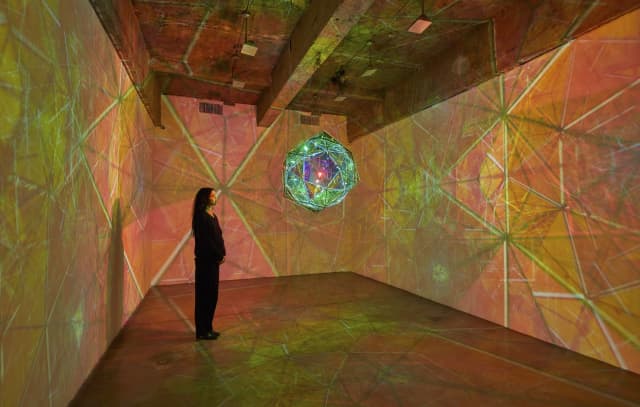
‘Edgy but perfect kinship sphere’, an artwork in Olafur’s solo exhibition ‘Your ocular relief’ at Tanya Bonakdar Gallery in New York. On view through 24 April. Photo: Tom Powel Imaging